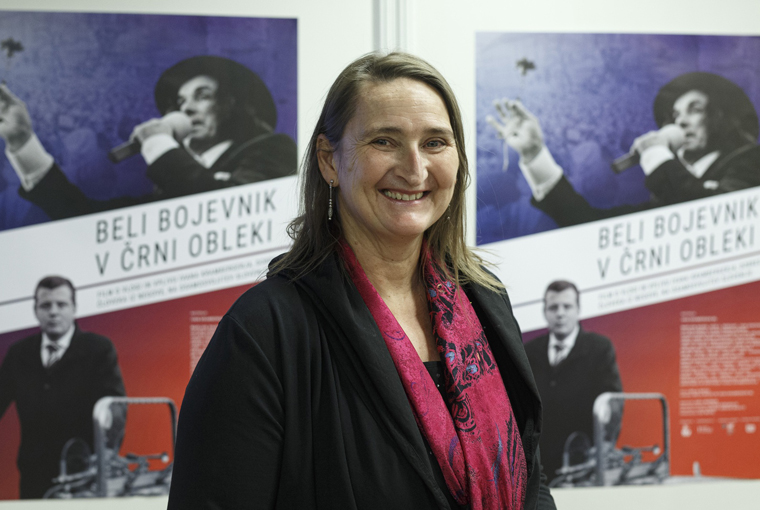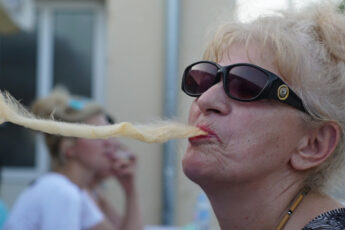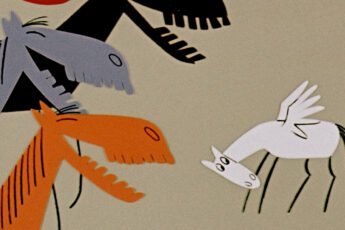
We met Slovenian filmmaker Maja Weiss at this year’s goEast film festival (26 April–2 May), which she attended for a special screening of her 2002 film “Guardian of the Frontier”. We spoke to Weiss about how she perceives her debut feature today, its aesthetic choices, and why she thinks it has remained relevant.
What does your film mean to you after all these years? How do you feel your work has evolved since then?
I think the last time I watched it was 10 years ago. Watching it again here at the goEast film festival was beautiful, because I think it is still very topical. The context of the borders, of the politics even. And of course, it is still modern in its cinematic language – the music, and the way it’s made. Still, this film premiered at the Berlinale in 2002 – so of course there are things that could have been done in a different way.
It was my debut fiction feature. There were some compromises that we had to make. For example, there was the scene of them traveling in the car. Today, that scene would have been easier to shoot, but at the time, installing the 35mm camera was very challenging. With today’s digital technology, it would be easier and quicker to execute.
In the Q&A after the film, you spoke about capturing the Zeitgeist. Your film has many elements of surrealism – what inspired you back then? Some elements are reminiscent of David Lynch’s Mulholland Drive, but the film had not come out when you were shooting, right?
My main inspiration was John Boorman’s Deliverance (1972), which I saw as a kid. It’s a canoe trip movie starring men, with a beautiful score.
But it’s interesting that Mullholland Drive (2001) came out at the same time as Guardian of the Frontier (2002) – and that I hadn’t seen it at the time. In Mullholland Drive, there were also sensual scenes with two beautiful lesbian women, and there is a similarity in how it’s made from a visual standpoint. And also the scene where Simona is in a bath tub with flower petals – it probably reminds the whole audience of American Beauty (1999). But I created Guardian of the Frontier before I saw any of this in the cinema.
It’s interesting how these things interact, how artists tackle the same topics and aesthetic challenges at a similar time.
Yes. The interesting thing is also that it was shot on 35 millimeters, and it was the first female-directed 35 mm, feature-length fiction film from Slovenia. It felt like climbing Mount Everest at the time! Today, young people don’t necessarily know what 35 mm is, let alone what working with analogue film means. Back then, it was a really big deal.
The shooting process was also a little different. For this project, I worked with the cameraman Bojan Kastelic – we had already collaborated on my short film Adrian (1998), which was very successful. It traveled to over 40 film festivals and also received awards as the best Channel + film and as the best Slovenian short film in Sarajevo.
So for Guardian of the Frontier, we took the next big aesthetic step. To attain this shiny picture, we worked with a lot of light. Of course, it’s summertime, the sun is shining – but most of the strong shiny light in the film was actually from additional lighting, which created this glamorous picture. My idea was that all the unpleasant problems that the girls face, all their unsettling questions about the border, should contradict the beauty of nature and of youth. For the colors, I was inspired by a painting of Paul Gaugin called „The Bathers“ (1897). It shows women, some of them wearing colorful dresses, counterposed by this green natural environment. I remember saying to myself, „I would like my film to have these kinds of colors and to be just as shiny.“
And this is beautiful, art influencing actions and other artworks. Searching for the right inspiration. I miss this. Now I haven’t done a fictional film in 15 years, because I couldn’t make it through the film commission – my projects were rejected six times. I miss the teamwork in the fiction film world, the different sectors, where everyone can contribute, I miss the auteur work. Of course, it’s the vision of the director everyone follows, but everyone can be part of this, everyone can contribute, grow, and give something. Plus, working with actors. At my 58 years of age, I am hoping that I will have the opportunity to create a fictional piece at least one more time.
How did you go about arranging this set of characters? Simona seems to be the protagonist – her sanity is frequently questioned throughout the film and until the very end, we remain unsure of what actually happened…
Well, my professor who taught film theory in film school plays Alja’s strange father, who touches Simona inappropriately at one point. He asked me about it once, since he knew that the film is also partly autobiographical, but I didn’t answer too concretely.
However, I really went on this trip with girls from my film school. There were four of us, not three. But of course, I was a little bit inspired by us going on that trip, by our characters – we were all students of film at the time. I related this idea to a well-known writer, who comes from the same region as me, the region you see in the film. I asked if he would collaborate with me for the dialogues, since these are always difficult to write, and he was experienced with writing drama. So the story incorporated both autobiographical elements and those which we invented. There were a lot of moments from the trip that had inspired me.
In a way, Simona is the protagonist. But I also like to think that all of these three girls are like one single woman. I think that every woman can find some questions that are also relevant to their lives in all of these three girls – questions of borders, questions of relating to men and the wider environment, questions of friendship. All of these topics are addressed in the film.
So when Iva Krajnc, who played Simona, got the award for Best Actress at the Slovenian National Film Festival, I was really very happy, but I also thought to myself: „Why didn’t they give it to all three of them?“.
In the film, the tension is very tangible – what was your approach to attaining this?
This was the very first film project for the main actresses, these were the first roles they played. Especially the actresses playing Simona and Zana went on to play other lead roles after this. So in one way, it was easy to work with the actresses, because they have this talent that they would later keep developing. But in another way, I also always play the scene in my mind, as a director. I’m the kind of person for whom it is sometimes easier to show the actors what I mean by acting out a scene myself as opposed to trying to verbalize what I am aiming at.
The explicit intimate scene between the two women was not written like this in the script. We shot it in a studio on a rainy day, and we had a lot of time to go about it. We took our time, we didn’t have to hurry. I think this is how we reached this believable tension.
The film still feels very topical. Even nowadays, lesbian characters and desires are depicted way more seldomly than gay men. What can you say about the struggle of the LGBTQ+ community in Slovenia over the two past decades?
For me personally, it was never so much of an issue; sexuality and who is what. To me, there was never a border. But I know that in society, such questions area always very big issues. I still remember supporting some of my friends who are part of the LGBTQ+ community. I remember one famous place in Ljubljana in the 90s that many famous people frequented who didn’t themselves identify as LGBTQ+ in order to support the cause. Together with a very good friend of mine, we tried to make My Name is Damian, a film about a transgender teenager, a project which was rejected three times. It was supposed to be a portrait of one of the main activists of LGBTQ+ rights in Slovenia, who has been active since the 1980s. I also believe the first exclusively queer film festival of Europe was actually established in Ljubljana in the 80s.
Just now, there is a new documentary film about the queer activist scene, Lgbt_Slo_1984 (2022) by Boris Petkovic. There, they also refer to Guardian of the Frontier as the first professional film to address the issue in Slovenia.
How do you perceive modern day feminism compared to to what you were witnessing in the 2000s?
What I think about feminism? Well, I always believe that you have to fight for your rights. It doesn’t have to concern gender or sexuality. Right now, I am actually an activist, because my daughter has Asperger’s syndrome. I think this movement is in its early stages, like the LGBTQ+ community was about 30 or 40 years ago.
So, groups like this need to fight by themselves, to be self-advocates. But they also need support from famous people, who fight for them as advocates. This way, something in our society can be changed for the better. We need to know the issues, the problems, the people and to overcome our barriers and borders – again this is about borders – so we can really live in an inclusive society. I think that society should be a space for everybody and minorities of any kind should have the equal rights as the majority. Of course, this often also has to do with political power and financial power. Often, people can only spread knowledge and awareness from such positions of power.
At the beginning, in my youth, it was also like this with equal rights for women and feminism. Today when I observe Slovenian society, I am happy that there are a lot of female directors who are very successful. Urška Djukić for example has won the Golden Bear and a César award. Of course, this is her own achievement and talent. But I also believe that we have come a long way.
When I stepped into the film industry, there were only men in commissions to decide which films are being made. I think there should be equality here. Arguably, we should also think about quotas. I know that in the beginning, I was the only woman, and that I had to fight extra hard. I think we can speak of success for the cause if men themselves are beginning to wonder if there are enough women in leadership positions. And I do believe that that question is being asked in Slovenia today.
Thank you for the interview.




Leave a Comment